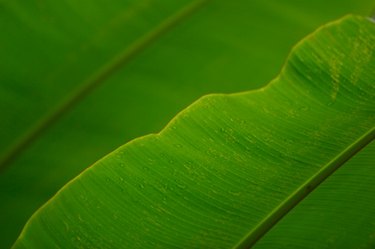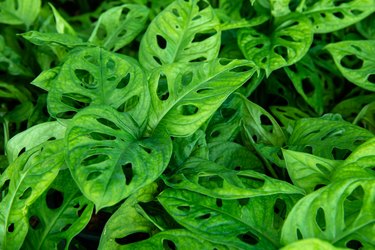Things You'll Need
Pencil and paper
Tree identification textbook
Magnifying glass
Digital camera

You can easily identify different types of trees by looking at the overall shape of the leaf and the pattern of the leaves on a tree. Try the five-point system to help you correctly identify tree leaves. It's a step-by-step process that progresses logically. To get started, examine each leaf carefully to see whether the edge is smooth, pointy or wavy. Count how many leaves are on one petiole, which is the delicate stem that connects the body of the leaf to the main stem. Record all your observations to make sure you remember what you found. Snap a photo to check your finding.
Step 1: Alternate or Opposite?
Differentiate between alternate and opposite leaf arrangements. The petioles of alternate leaves attach to the central stem at unrelated points, and the petioles of opposite leaves join the stem at corresponding intervals. Look at whether the leaves on one side of the petiole mirror the leaves on the opposite side. If they do, you know you have an opposite configuration.
Video of the Day
Step 2: Simple and Compound Leaf Structures
Distinguish simple leaf structures and compound leaf structures. Look for one, single leaf attached to the petiole to identify a simple structure. Look for numerous, small leaflets attached to the petiole to identify the compound variety. Leaflet, compound constructions are found on hickory, sumac, walnut, ailanthus and locust trees, and their sub-species. Draw the shape you see with pencil and paper to improve the comparison between the leaf you want to identify and any textbook or reference list you carry.
Step 3: Wide Leaves and Needle Leaves

Identify the difference between wide-based leaves and needle-shaped leaves. Use a magnifying glass if you need to. Needles are less common than wide-based leaves, so this needs to be checked before you try to locate the differences between the wide-based varieties. Needle-shaped leaves can differ, too, so look for smooth needles or scaly needles. For example, red cedar trees have scaly needles, and pine trees have smooth needles.
Step 4: Look at Leaf Edge Patterns
Study the shape of the outer edge of one leaf. Look for straight, wavy or toothed patterns along each leaf edge. Wavy leaves, like that of the white oak leaf, have several rounded lobes and corresponding indentations called sinuses. Look for shallow sinuses and deep sinuses to identify different tree species. Toothed leaves have a jagged, repeating pattern along their outermost edge and give the appearance of being hairy or sharp, depending on the species. The elm is a classic example of a toothed leaf.
Step 5: Palmate Lobes or Pinnate Lobes
Find out if the leaves of lobed leaf trees have palmate lobes or pinnate lobes. Palmate lobes are arranged in the shape of a hand, like a palm, with several, defined points that make the whole leaf. The leaf of the tulip poplar is an example. Pinnate lobes are arranged in a line and have the rounded lobe/sinus appearance. Take a digital photograph of a leaf if you wish to build up your own library of information for a website or local paper.
Step 6: Start With Common Trees

As a general rule, pick out common trees first to speed up the identification process. Most types of maple leaves, for example, have a well known shape with five sharp points and attractive symmetry. Study more unusual leaf patterns and structure to identify less common tree species, or ones that you haven't come across before. For example, the red oak is a variation on the deep lobed structure. Rather than each lobe being rounded, like the white or common oak, the red oak has leaves with sharp, pointed lobes. This contrasts dramatically with the redbud, which has a straight, smooth edge and one point at the top. Redbud leaves have a heart shape if you hold them with the petiole at the top.
Tip
You will identify leaves and trees of interest more easily by carrying an identification list or reference book with you. Try to use one that relates to the particular area or country you are working in. Keep in mind that every tree has at least one common name, like green ash, but only one scientific name, like Fraxinus pennsylvanica.
Warning
Ask for permission to take a cutting of a tree if you are on private land or think the land may be protected. Take a photograph instead if you can. Never uproot an entire sapling or small tree in order to identify it as the tree will likely die and you could face prosecution if the area is under conservation.
Video of the Day